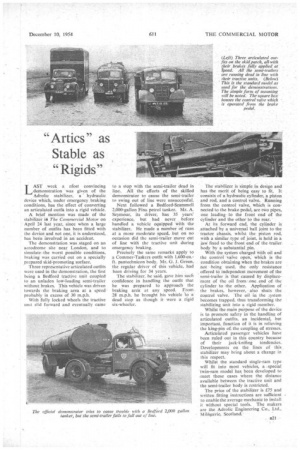"Artics" as Stable as "Rigids"
Page 55

If you've noticed an error in this article please click here to report it so we can fix it.
LAST .week a nfost convincing demonstration was given of the Adrolic stabilizer, a hydraulic device which, under emergency braking conditions, has the effect of converting an articulated outfit into a rigid vehicle.
A brief mention was made of the stabilizer ih The Commercial Motor on April 24 last year, since when a large number of outfits has been fitted with the device and not one, it is understood, has been involved in an accident.
The demonstration was. staged on an aerodrome site near London, and to simulate-the worst possible conditions, braking was carried out on a specialty prepared skid-promoting surface.
Three representative articulated outfits were used in the demonstration, the first being a Bedford tractive unit coupled to an unladen low-loading semi-trailer without brakes. This vehicle was driven towards the braking area at a speed probably in excess of 30 m.p.h.
With fully locked wheels the tractive unit slid forward and eventually came to a stop with the semi-trailer dead in liae._ All the efforts of the skilled demonstrator to cause the semi-trailer to swing out of line were unsuccessful.
Next followed a Bedford-Scarnmell 2,600-gallon Fina petrol tanker. Mr. A. Seymour, its driver, has 35 years' experience, but had never before handled a vehicle equipped with the stabilizer. He made a number of runs at a moremoderate speed, but on no occasion did the semi-trailer move out of line with the tractive unit during emergency braking.
Precisely the same remarks apply to a Commer-Taskers outfit with 1,600-cu.ft. pantechnicon body. Mr. G. J. Green, the regular driver of this vehicle, had been driving for 34 years. The stabilizer, he said, gave him such confidence in handling the outfit that he was prepared to approach the braking area at any speed. From 28 m.p.h. he brought his vehicle lo a dead stop as though it were a rigid six-wheeler. The stabilizer is simple in design and has the merit of being easy to fit. It consists of a hydraulic cylinder, a piston and rod, and a control valve. Running from the control valve, Which is connected to the brake pedal, are two pipes, one leading to the front end of the cylinder and the other to the rear.
At its forward end, the cylinder is _attached by a universal ball joint to the tractor chassis, whilst the piston rod, with a similar. type of joint, is held in a jaw fixed to the front end of the trailer body by a substantial •pin.
With the system charged with oil and the control 'valve open," which is the condition obtaining when the brakes are not being used, the only resistance offered to independent movement of the semi-trailer, is that caused by displacement of the oil fromOne end of the cylinder -to the other. Application of the brakes, however, also shuts the control valve. The oil in the system becomes trapped, thus transforming the stabilizing unit into a rigid member.
Whilst the main purpose of the device is to promote safety in the handling of articulated outfits, an incidental, but important, function of it is in relieving the king-pin of the coupling of stresses.
Articulated passenger vehicles have been ruled out in this country because of their jack-knifing tendencies. Developments on the lines of this stabilizer may bring about a change in this respect.
Whilst the standard single-ram type will fit into most vehicles, a .speeial "twin-ram model has, been developed to meet those cases where the distance available between the tractive unit and the semi-trailer body is restricted.
The price of the stabilizer is £75 and written fitting instructions are sufficient to enable the average mechanic to install it without special tools. The makers are the Adrolic Engineering Co., Ltd., Milngavie, Scotland.




















































































































